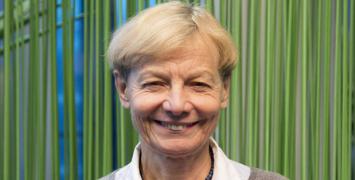Women in science - Gender balancing at the ERC
What are your responsibilities as member of the ERC's Scientific Council?
The Scientific Council (SC) is at the heart of the ERC. It has a number of important responsibilities, including deciding how to run the ERC’s program, which evaluators/reviewers to choose and how to distribute the budget between the different grant schemes. When joining the ERC, Council members are given a choice of working groups to join. The working groups (WGs) take an in-depth look into certain issues that have been identified as important. They initiate the gathering and analysis of any necessary relevant data, and make recommendations to the SC on how to address any problems that become evident. I chose the Widening European participation WG and the Gender Balance WG.
In view of the upcoming International Day of Women and Girls in Science, how can the number of women in research be increased?

Maybe by not transmitting gender stereotypes from a young age. Studies show that by the age of 6 or 7 young girls associate the concept of brilliance mainly with boys rather than their own sex whereas this does not occur at the age of 5. It is a very narrow window; therefore, intervention needs to be made very early on. I believe that the sum of numerous small changes made by many people, over a number of areas, can really make a difference. It is very important to recognise and celebrate female role models - private initiatives such as the efforts made to highlight the roles of women in science on Wikipedia can help ensure that women in science are not invisible.
As a molecular biologist, have you seen any positive developments in gender balance in your particular field, within or outside the ERC?
The success rate of women winning ERC grants in the life sciences domain is the lowest of any field, even if the gap has closed a little over time. In the external research community, the area is seen as very competitive and some areas can demand long hours of being physically present in the lab. Thankfully, there is now more awareness of the negative effects of gender imbalance in all scientific fields, and attempts have been made to address it, either through national or EU policies. However, leadership has often been associated with characteristics exhibited by men in the workplace, and this attitude is proving hard to change.
EU funded projects to increase the representation and participation of women in leadership positions in sciences - such as LIBRA (that I coordinate in the Life Sciences field) - are very useful to stimulate change research institutes across Europe.
Has the ERC achieved gender balance in its overall grant awards?
From 2007 to 2013 the success rate of women ERC applicants was on average 8% (as compared to 11% for male applicants). The overall current rate is now approximately the same for both men and women, at 13%.
In the past, far fewer women applied for ERC grants than men – from 2009 to 2018, on average, 26% of grant applications were from women. To put this in context, it is worth noting that the lower share of women in the ERC is likely to reflect the overall situation in terms of gender balance in science in Europe. In addition, there are major variations between applications to different research disciplines. This is also the case between funding schemes; for instance, the share of women applying for ERC Starting Grants is higher than for ERC Advanced Grants, reflecting the higher presence of women in science in early career stages.
While in overall terms, the gap between male and female success rates is closing - and this is very satisfying to see - in the future I hope for consolidation in the gender balance of success rates in all domains of ERC grants.
What does the ERC do to ensure gender equality in its scientific research granting process?
Whilst always keeping excellence as the sole project evaluation criterion, the ERC takes gender issues very seriously. The main actions were proposed by the Gender Balance Working Group, of which I am the Chair since 2013. Its aim is not only to counteract gender bias but to ensure equal opportunities, by working on many different levels.
Main objectives of the ERC Scientific Council Gender Equality Plan:
1. raising awareness about the ERC gender policy among potential applicants; 2. working towards improving gender balance among ERC candidates and within ERC-funded research teams; 3. identifying and guarding against any potential gender bias in the ERC evaluation procedures; 4. embedding gender awareness within all levels of the ERC processes - while keeping focus on excellence; 5. striving for gender balance among the ERC peer reviewers and other relevant ERC bodies.
Taking into account the aims of the ERC Scientific Council Gender Equality Plan, if we look at the evaluators who recommend which research proposals receive grants, we have been able to ensure that panel members are briefed by video (below) to raise their awareness and avoidance of potential gender bias in their behaviour. We are also producing an additional instructive video to supplement their awareness.
Watching this video you are accepting Youtube cookies policy
While we did not find any evidence that the proportion of women in evaluation panels has any impact on the success rate of women applicants (and indeed it should not as excellence is the only criteria), I feel balancing genders on panels is important on a different level. It contributes to the diversity of opinion, and gives experience that can be useful on other occasions. The WG therefore also monitors gender distribution within the ERC’s peer review system. Its aim is to achieve a gender balance in each ERC evaluation panel that better reflects that of the panel's relevant scientific communities.
Bias awareness training was initiated for the ERC’s Executive Agency staff who are involved in the selection procedures for grant candidates. The staff who monitor the progress of the grants also notify the WG of any gender related issues that crop up that require attention, so that recommendations can be made to change related policies, if necessary.
ERC staff take part in scientific conferences and workshops addressing gender topics, to take an active role in the gender debate but also to inform participants about ERC actions to ensure equal treatment of candidates. When announcing the results of grant competitions, the ERC makes sure to highlight the projects of both male and female grantees, to provide tangible role models for potential applicants.
As you will be leaving your position as ERC Scientific Council member in the summer of 2019, what are your hopes for the ERC in the future?
I hope the original character and culture of the ERC is maintained. At this point most of the original Scientific Council members have left and naturally, the Council has evolved along with the new members. When I joined, many of the founders were still present. These scientists attempted to create an organisation based on excellence and run in the simplest way possible – which I felt was not the case for many EU projects at the time. The aim was to identify and fund excellent research projects and to involve only as much administration as was necessary to support and show the outcome of the projects; meaning a sufficient administrative level from the perspective of scientists rather than civil servants!
The funding level and duration of the grants was intended to give researchers enough time and money to achieve an ambitious objective. The most valuable aspects of core ERC grants are that they don’t impose a research topic or anticipate the application of research results. At the time, it was very unusual for grant recipients to be allowed such freedom, and it enabled big discoveries. It is vital that these attributes are maintained.
Finally, I also hope the ERC manages to increase its budget. It is disappointing to see that due to lack of funds, only some of the applications rated with an A grade can be funded.
Do you have any fears for the ERC or fundamental science in Europe?
There seems to be a growing perception in Europe that the ERC is responsible for all funding of basic science. Funding restrictions at EU level mean this is not a viable scenario. As mentioned above, it cannot even fund all the excellent proposals it receives! Moreover, the danger is that other funders, for example at a national level, do not step up and play their part.
In the interests of efficiency, I also hope the ERC does not change in structure. That the Scientific Council will continue to be the “brain” of the ERC and in particular that it is not enveloped into a standard administrative body.
Would you recommend working as a member of the ERC's Scientific Council to others?
Working for the ERC means working for science in Europe. It is definitely worth doing and in fact it is also a necessary duty since the aim is to foster excellent research at the European level. At the same time, if you want to make a significant contribution it’s also a challenge for an active scientist. Council members attend five plenary meetings per year, we review many documents, we act as observers in evaluation meetings, and we occasionally chair panel meetings. We also attend numerous related events. I am asked to many conferences on gender balance matters alone.
Nevertheless, this work must be carried out by scientists. It is both enriching work and a wonderful opportunity to meet people working in other fields and make contacts that may not have occurred otherwise.

Isabelle Vernos is a research professor at ICREA (Institució Catalana de Recerca i Estudis Avançats), Centre de Regulació Genòmica, Barcelona, Spain and an EMBO member since 2005. In the past, she worked at the Welcome CRC Institute, Cambridge, UK and at the European Molecular Biology Laboratory (EMBL) in Heidelberg, Germany. Research in her lab is directed at understanding the role of the microtubule network in cell organization and function. To address this question her group study various microtubule-associated proteins and their regulators to unravel how the self-organization of cellular components results in the morphogenesis of dynamic molecular machines.





